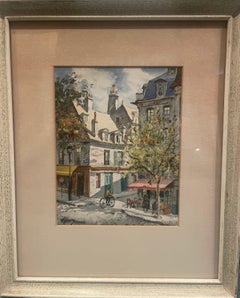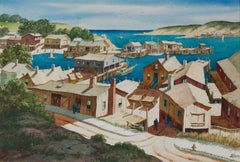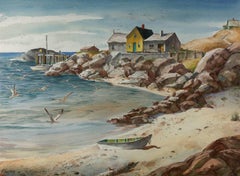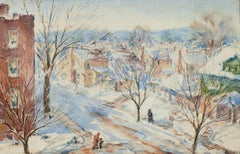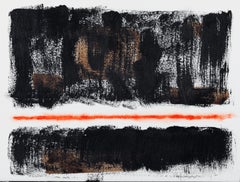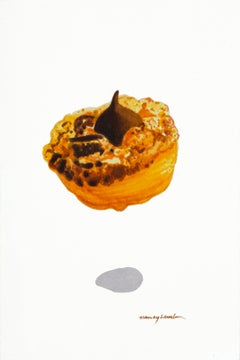Art by Medium: Watercolor
to
7
3
6
1
2
3
2
Overall Height
to
Overall Width
to
3
1
1
3
2
2
1
1
1
1
1
1
1
1
1
1
1
1
1
1
1
1
1
7
1
12
236
213
205
172
11
7
6
4
2
Artist: Henry Martin Gasser
Medium: Watercolor
“Montmartre in July”
Located in Southampton, NY
Beautiful, original watercolor by the well known American artist, Henry Martin Gasser. Signed lower right by the artist “Gasser/Paris. Titled verso. Circa 1965. Condition is excelle...
Category
1960s Post-Impressionist Art by Medium: Watercolor
Materials
Archival Paper, Watercolor
Winter Night
Located in New York, NY
Henry Martin Gasser paints a snow-filled town road with a single car driving along it in his watercolor entitled “Winter Night.”
Category
Mid-20th Century Art by Medium: Watercolor
Materials
Pencil, Watercolor, Paper
“Paris Summer Corner”
Located in Warren, NJ
“Paris summer corner”
In good condition
Stamp of the artist and title are on the back of the picture
Measures 18x14
International buyers must cover shipping cost
Category
Mid-20th Century Art by Medium: Watercolor
Materials
Watercolor
Gloucester Vista
Located in New York, NY
Signed lower right: H. GASSER; on verso: “Gloucester Vista” / HENRY GASSER / N.A.
Category
20th Century American Modern Art by Medium: Watercolor
Materials
Paper, Watercolor, Gouache
Sand, Sea, and Rocks
Located in New York, NY
Signed lower left: H. GASSER
Category
20th Century American Modern Art by Medium: Watercolor
Materials
Watercolor, Paper, Gouache
Newark Street Snow Scene in Sunlight with Figures
Located in New York, NY
Signed lower right: H. GASSER
Category
20th Century American Modern Art by Medium: Watercolor
Materials
Paper, Watercolor
Winter Coastal Scene
Located in Milford, NH
A fine winter coastal scene by American artist Henry Martin Gasser (1909-1981). Painter, lecturer, teacher and illustrator Henry Gasser was born in New...
Category
Mid-20th Century American Impressionist Art by Medium: Watercolor
Materials
Paper, Watercolor
Related Items
Thread
By Ed Touchette
Located in Gloucester, MA
Ed Touchette (b. 1948) is inspired by a love of architecture and public spaces to make paintings which express joyful wonder at our built environment — ol...
Category
2010s Bauhaus Art by Medium: Watercolor
Materials
Ink, Acrylic, Watercolor
Contemporary American Still Life of Hershey's Kiss Cake, Chocolate Dessert Treat
By Nancy Lamb
Located in Fort Worth, TX
Nancy Lamb, Kiss Cake, 2020, Watercolor on Paper, 5.5 x 3.5."
Contemporary American Still Life of Hershey's Kiss Cake, Chocolate Dessert Treat.
This fan...
Category
21st Century and Contemporary American Realist Art by Medium: Watercolor
Materials
Watercolor, Paint, Paper
The Abduction of the Sabine Women , a Renaissance drawing by Biagio Pupini
Located in PARIS, FR
This vigorous drawing has long been attributed to Polidoro da Caravaggio: The Abduction of the Sabine Women is one of the scenes that Polidoro depicted between 1525 and 1527 on the façade of the Milesi Palazzo in Rome. However, the proximity to another drawing inspired by this same façade, kept at the Ecole des Beaux-Arts, and to other drawings inspired by Polidoro kept at the Musée du Louvre, leads us to propose an attribution to Biagio Pupini, a Bolognese artist whose life remains barely known, despite the abundant number of drawings attributed to him.
1. Biagio Pupini, a Bolognese artist in the light of the Roman Renaissance
The early life of Biagio Pupini, an important figure of the first half of the Cinquecento in Bologna - Vasari mentions him several times - is still poorly known. Neither his date of birth (probably around 1490-1495) nor his training are known. He is said to have been a pupil of Francesco Francia (1450 - 1517) and his name appears for the first time in 1511 in a contract with the painter Bagnacavallo (c. 1484 - 1542) for the frescoes of a church in Faenza. He then collaborated with Girolamo da Carpi, at San Michele in Bosco and at the villa of Belriguardo.
He must have gone to Rome for the first time with Bagnacavallo between 1511 and 1519. There he discovered the art of Raphael, with whom he might have worked, and that of Polidoro da Caravaggio. This first visit, and those that followed, were the occasion for an intense study of ancient and modern art, as illustrated by his abundant graphic production.
Polidoro da Caravaggio had a particular influence on the technique adopted by Pupini. Executed on coloured paper, his drawings generally combine pen, brown ink and wash with abundant highlights of white gouache, as in the drawing presented here.
2. The Abduction of the Sabine Women
Our drawing is an adaptation of a fresco painted between 1525 and 1527 by Polidoro da Caravaggio on the façade of the Milesi Palace in Rome. These painted façades were very famous from the moment they were painted and inspired many artists during their stay in Rome. These frescoes are now very deteriorated and difficult to see, as the palace is in a rather narrow street.
The episode of the abduction of the Sabine women (which appears in the centre of the photo above) is a historical theme that goes back to the origins of Rome and is recounted both by Titus Livius (Ab Urbe condita I,13), by Ovid (Fasti III, 199-228) and by Plutarch (II, Romulus 14-19). After killing his twin brother Romus, Romulus populates the city of Rome by opening it up to refugees and brigands and finds himself with an excess of men. Because of their reputation, none of the inhabitants of the neighbouring cities want to give them their daughters in marriage. The Romans then decide to invite their Sabine neighbours to a great feast during which they slaughter the Sabines and kidnap their daughters.
The engraving made by Giovanni Battista Gallestruzzi (1618 - 1677) around 1656-1658 gives us a good understanding of the Polidoro fresco, allowing us to see how Biagio Pupini reworked the scene to extract this dynamic group.
With a remarkable economy of means, Biagio Pupini takes over the left-hand side of the fresco and depicts in a very dense space two main groups, each consisting of a Roman and a Sabine, completed by a group of three soldiers in the background (which seems to differ quite significantly from Polidoro's composition).
The balance of the drawing is based on a very strongly structured composition. The drawing is organised around a median vertical axis, which runs along both the elbow of the kidnapped Sabine on the left and the foot of her captor, and the two main diagonals, reinforced by four secondary diagonals. This diamond-shaped structure creates an extremely dynamic space, in which centripetal movements (the legs of the Sabine on the right, the arm of the soldier on the back at the top right) and centrifugal movements (the arm of the kidnapper on the left and the legs of the Sabine he is carrying away, the arm of the Sabine on the right) oppose each other, giving the drawing the appearance of a whirlpool around a central point of support situated slightly to the left of the navel of the kidnapper on the right.
3. Polidoro da Caravaggio, and the decorations of Roman palaces
Polidoro da Caravaggio was a paradoxical artist who entered Raphael's (1483 - 1520) workshop at a very young age, when he oversaw the Lodges in the Vatican. Most of his Roman work, which was the peak of his career, has disappeared, as he specialised in facade painting, and yet these paintings, which are eminently visible in urban spaces, have influenced generations of artists who copied them abundantly during their visits to Rome.
Polidoro Caldara was born in Caravaggio around 1495-1500 (the birthplace of Michelangelo Merisi, known as Caravaggio, who was born there in 1571), some forty kilometres east of Milan. According to Vasari, he arrived as a mason on the Vatican's construction site and joined Raphael's workshop around 1517 (at the age of eighteen according to Vasari). This integration would have allowed Polidoro to work not only on the frescoes of the Lodges, but also on some of the frescoes of the Chambers, as well as on the flat of Cardinal Bibiena in the Vatican.
After Raphael's death in 1520, Polidoro worked first with Perin del Vaga before joining forces with Maturino of Florence (1490 - 1528), whom he had also known in Raphael's workshop. Together they specialised in the painting of palace façades. They were to produce some forty façades decorated with grisaille paintings imitating antique bas-reliefs.
The Sack of Rome in 1527, during which his friend Maturino was killed, led Polidoro to flee first to Naples (where he had already stayed in 1523), then to Messina. It was while he was preparing his return to the peninsula that he was murdered by one of his assistants, Tonno Calabrese, in 1543.
In his Vite, Vasari celebrated Polidoro as the greatest façade decorator of his time, noting that "there is no flat, palace, garden or villa in Rome that does not contain a work by Polidoro". Polidoro's facade decorations, most of which have disappeared as they were displayed in the open air, constitute the most important lost chapter of Roman art of the Cinquecento. The few surviving drawings of the painter can, however, give an idea of the original appearance of his murals and show that he was an artist of remarkable and highly original genius.
4. The façade of the Milesi Palace
Giovanni Antonio Milesi, who commissioned this palace, located not far from the Tiber, north of Piazza Navona, was a native of the Bergamo area, like Polidoro, with whom he maintained close friendly ties. Executed in the last years before the Sack of Rome, around 1526-1527, the decoration of Palazzo Milesi is considered Polidoro's greatest decorative success.
An engraving by Ernesto Maccari made at the end of the nineteenth century allows us to understand the general balance of this façade, which was still well preserved at the time. The frescoes were not entirely monochrome, but alternated elements in chiaroscuro simulating marble bas-reliefs and those in ochre simulating bronze and gold vases...
Category
16th Century Old Masters Art by Medium: Watercolor
Materials
Ink, Gouache, Pen
Christopher Street (abstract Greenwich Village cityscape)
Located in Wilton Manors, FL
De Hirsh Margules (1899-1965). Christopher Street, 1939. Watercolor on Arches wove paper. Signed and dated in pencil by artist lower margin. Sheet measures 15.5 x 20 inches. Window in matting measures 15 x 19 inches. Framed measurement: 23 x 30 inched. Bears fragment of original label affixed on verso. Incredibly vibrant and saturated color with no fading or toning of sheet.
Provenance: Babcock Galleries, NYC
Exhibited: The American Federation of Arts Traveling Exhibition.
From the facade of The Waverly at Christopher is depicted One Christopher Street, the 16-story Art Deco residential building erected in 1931. It is not a casual coincidence that the structure appears in this cityscape: 1 Christopher Street is the subject. The original intention of this project was to transform the neighborhood, bring a bit of affluence and make a bid to rival the Upper West Side. Margules, a sensitive aesthete, understood how a massive piece of architecture such as One changes a neighborhood. Sound, scale and focal points are forever altered. A pedestrian's sense of depth and distance becomes pronounced. All of these factors contribute to the intent behind this image. Tall buildings disrupt the human scale, change the skyline and carve up space. In this piece, negative space conforms to the man-made geometries. Clouds become gems fixed in settings.
De Hirsh Margules (1899–1965) was a Romanian-American "abstract realist" painter who crossed paths with many major American artistic and intellectual figures of the first half of the 20th century. Elaine de Kooning said that he was "[w]idely recognized as one of the most gifted and erudite watercolorists in the country". The New York Times critic Howard Devree stated in 1938 that "Margules uses color in a breath-taking manner. A keen observer, he eliminates scrupulously without distortion of his material." Devree later called Margules "one of our most daring experimentalists in the medium"
Margules was also a well-known participant in the bohemian culture of New York City's Greenwich Village, where he was widely known as the "Baron" of Greenwich Village.[1] The New York Times described him as "one of Greenwich Village's best-known personalities" and "one of the best known and most buoyant characters about Greenwich Village.
Early Life
De Hirsh Margules was born in 1899 in the Romanian city of Iași (also known as Iasse, Jassy, or Jasse). When Margules was 10 weeks old, his family immigrated to New York City. Both of his parents were active in the Yiddish theater, His father was Yekutiel "Edward" Margules, a "renowned Jewish actor-impresario and founder of the Yiddish stage." Margules' mother, Rosa, thirty-nine years younger than his father, was an actress in the Yiddish theater and later in vaudeville. Although Margules appeared as a child actor with the Adler Family[11] and Bertha Kalich, his sister, Annette Margules, somewhat dubiously continued in family theater and vaudeville tradition, creating the blackface role of the lightly-clad Tondelayo (a part later played on film Hedy Lamarr) in Earl Carroll's 1924 Broadway exoticist hit, White Cargo. Annette herself faced stereotyping as an exotic flower: writing about her publicist Charles Bouchert stated that "Romania produces a stormy, temperamental type of woman---a type admirably fitted to portray emotion." His brother Samuel became a noted magician who appeared under the name "Rami-Sami." Samuel later became a lawyer, representing magician Horace Goldin, among others. A family portrait including a young De Hirsh, a portrait of Rosa and Annette together, and individual photos of Rosa and Edward can be found on the Museum of the City of New York website.
At around age 9 or 10, Margules took art classes with the Boys Club on East Tenth Street, and his first taste of exhibition was at a student art show presented by the club. By age 11, he had won a city-wide prize (a box camera) at a children's art show presented by the department store Wanamakers.
As a young teenager, Margules was already displaying a characteristic kindness and loyalty. Upon hearing that two friends (one of them was author Alexander King), were in trouble for breaking a school microscope, the nearly broke Margules gave them five dollars to repair the microscope . Margules had to approach a wealthy man that Margules had once saved on the subway from a heart attack. Margules didn't reveal the source of the five dollars to King until twenty-five years later.
In his late teens, Margules studied for a couple of months in Pittsburgh with Edwin Randby, a follower of Western painter Frederic Remington. Thereafter he pursued a two-year course of studies in architecture, design and decoration at the New York Evening School of Art and Design, while working as a clerk during the day at Stern's Department Store. He was encouraged in these artistic pursuits by his neighbor, the painter Benno Greenstein (who later went by the name of Benjamin Benno).
Artistic career
In 1922, Margules began work as a police reporter for the City News Association of New York .Margules then considered himself something of an expert on art, and the painter Myron Lechay is said to have responded to some unsolicited analysis of his work with the remark "Since you seem to know so much about it, why don't you paint yourself?" This led to study with Lechay and a flurry of painting.
Margules' first show was in 1922 at Jane Heap's Little Review Gallery. Thereafter Margules began to participate in shows with a group including Stuart Davis, Jan Matulka, Buckminster Fuller (exhibiting depictions of his "Dymaxion house") in a gallery run by art-lover and restaurateur Romany Marie on the floor above her cafe.
Jane Heap, left, with Mina Loy and Ezra Pound
During the 1920s, Margules traveled outside of the country a number of times. In 1922, with the intent of reaching Bali, he took a job as a "'wiper on a tramp steamer where [he] played nursemaid to the engine." He reached Rotterdam before he turned back. He would return to Rotterdam shortly thereafter.
In 1927, Margules took a lengthy leave of absence from his day job as a police reporter in order to travel to Paris, where he "set up a studio in Montmartre's Place du Tertre, on the top floor of an almost deserted hotel, a shabby establishment, lacking both heat and running water." He studied at the Louvre and traveled to paint landscapes in provincial France and North Africa.
Margules also joined the "Noctambulist" movement and experimented with painting and showing his artwork in low light.Jonathan Cott wrote that:
the painter De Hirsch Margulies sat on the quays of the Seine and painted pictures in the dark. In fact, the first exhibition of these paintings, which could be seen only in a darkened room, took place in [ Walter Lowenfels'] Paris apartment.
Elaine de Kooning remarked that studying the works of the Noctambulists confirmed Margules' "direction toward the use of primary colors for perverse effects of heavy shadow."
It was also in Paris that Margules initially conceived his idea of "Time Painting", where a painting is divided into sectors, each representing a different time of day, with color choices meant to evoke that time of day.
In Paris, his social circle included Lowenfels, photographer Berenice Abbott, publisher Jane Heap, composer George Anthiel, sculptor Thelma Wood, painter André Favory, writer Norman Douglas, writer and editor George Davis, composer and writer Max Ewing, and writer Michael Fraenkel.
Upon his return to New York in 1929, Margules attended an exhibition of John Marin's paintings.
While at the exhibition, he "launched into an eloquent explanation of Marin to two nearby women", and was overheard by an impressed Alfred Stieglitz. The famous photographer and art promoter invited Margules to dine with his wife, the artist Georgia O'Keeffe, and his assistant, painter Emil Zoler. Stieglitz thereafter became a friend and mentor to Margules, becoming for him "what Socrates was to his friends."
Alfred Stieglitz
Stieglitz introduced Margules to John Marin, who quickly became the most important painterly influence upon Margules. Elaine de Kooning later noted that Margules was "indebted to Marin and through Marin to Cézanne for his initial conceptual approach - for his constructions of scenes with no negative elements, for skies that loom with the impact of mountains." Margules himself said that Marin was his "father and ... academy." The admiration was by no means unreciprocated: Marin said that Margules was "an art lover with abounding faith and sincerity, with much intelligence and quick seeing." Stieglitz also introduced Margules to many other artistic and intellectual figures in New York.
With the encouragement of Alfred Stieglitz, Margules in 1936 opened a two-room gallery at 43 West 8th Street called "Another Place." Over the following two years there were fourteen solo exhibitions by Margules and others, and the gallery was well-respected by the press. It was in this gallery that the painter James Lechay, Myron's brother, exhibited his first painting.
In 1936, Margules first saw recognition by major art museums when both the Museum of Modern Art and the Museum of Fine Arts, Boston purchased his works.
In 1942, Margules gave up working as a police reporter, and apparently dedicated himself thereafter solely to an artistic vocation.
"The Baron of Greenwich Village"[edit]
Margules made his mark not only as an artist, but also as an outsized personality known throughout Greenwich Village and beyond.
To local residents, Margules was known as the "Baron", after Baron Maurice de Hirsch, a prominent German Jewish philanthropist. Margules was easily recognizable by the beret he routinely wore over his long hair. Writer Charles Norman said that he "dressed with a flair for sloppiness."
He was said to "know everybody" in Greenwich Village, to the extent that when the novelist and poet Maxwell Bodenheim was murdered, Margules was the first one the police sought to identify the body. Margules' letters show him interacting with art world figures such as Sacha Kolin, John Marin and Alfred Stieglitz, as well as with prominent figures outside the art world such as polymath Buckminster Fuller and writer Henry Miller.
Most of his friends and acquaintances found Margules a generous and voluble man, given to broadly emotionally expressive gestures and acts of kindness and loyalty. In 1929, he exhibited an example of this loyalty and fellow-feeling when he appeared in court to fight what the wrongful commitment of his friend, writer and sculptor Alfred Dreyfuss, who appeared to have been a victim of an illicit attempt to block an inheritance.
The Greenwich Village chronicler Charles Norman described the bone-crushing hugs that Margules would routinely bestow on his friends and acquaintances, and speaks of the "persuasive theatricality" that Margules seemed to have inherited from his actor parents. Norman also wrote about Margules' routine acts of kindness, taking in homeless artists, constantly feeding his friends and providing the salvatory loan where needed. Norman also notes that Margules was blessed with a loud and good voice, and was apt to sing an operatic air without provocation.
The writer and television personality Alexander King said
I think the outstanding characteristics of my friend's personality are affirmation, emphasis, and overemphasis. He chooses to express himself predominantly in superlatives and the gestures which accompany his utterances are sometimes dangerous to life and limb. Of the bystanders, I mean.
King also spoke with affectionate amusement about Margules' pride in his cooking, speaking of how "if he should ever invite you to dinner, he may serve you a hamburger with onions, in his kitchen-living room, with such an air of gastronomic protocol, such mysterious hints and ogliing innuendoes, as if César Ritz and Brillat-Savarin had sneaked out, only a moment before, with his secret recipe in their pockets."
Margules was such a memorable New York personality that comic book writer Alvin Schwartz imagined him at the Sixth Avenue Cafeteria in a risible yet poignant debate with Clark Kent about whether Superman had the ability to stop Hitler.
Margules' entrenchment in the Greenwich Village milieu can be seen in a photograph from Fred McDarrah's "Beat Generation Album" of a January 13, 1961 writers' and poets' meeting to discuss "The Funeral of the Beat Generation", in Robert Cordier [fr]'s railroad flat at 85 Christopher Street. Among the people in the same photograph are Shel Silverstein...
Category
1930s American Modern Art by Medium: Watercolor
Materials
Watercolor, Rag Paper
Abstract Watercolor N.8 by Dmitry Samygin
Located in Paris, FR
Abstract Watercolor N.8 by Dmitry Samygin
Minimalist and geometric paintings.
Technique: Watercolor
Color: Teal blue
Size: H. 35.5 x 27.5 x 0.1 cm
Dmitry Samygin is a Furniture a...
Category
21st Century and Contemporary Abstract Geometric Art by Medium: Watercolor
Materials
Watercolor
India Watercolour RCA Architect Painting Palace Udaipur Lake Travel Orange Blues
Located in Norfolk, GB
There is something compelling about drawings and sketches made by architects. Loose and full of life this delicious little study, made on the spot, beautifully captures the essence of place. Made during one of Patterson's early tours to India it shows the gloriously majestic Palace Museum in Udaipur, Rajasthan, which sits on the highest point overlooking Lake Pichola and the City. The delicate wash of terracottas, pinks and reds offers us the feel of sun on the old stones.
India Palace Museum (Udaipur), watercolour & pencil on paper, image 9.5cm x 14cm, framed 21.5cm x 24.5cm, Artist Stamp, signed in pencil bottom left, 1990
Doug Patterson...
Category
1990s Contemporary Art by Medium: Watercolor
Materials
Watercolor, Archival Paper, Pencil
1950s "Forest Through Window" MidCentury Abstract Gouache University of Paris
By Donald Stacy
Located in Arp, TX
Donald Stacy
"Forest Through the Window"
c.1950s
Oil pastel and gouache paint on paper
14" x 17" unframed
Unsigned
Came from artist's estate
Donald Stacy (1925-2011) New Jersey
Studied: Newark School of Fine Art
The Art Students League
Pratt Graphic Arts Center
University of Paris 1953-54
University of Aix-en-Provence 1954-55
Faculty: Art Department of the New School
Museum of Modern Art
School of Visual Arts
Stacy Studio Workshop
Exhibitions: Grand Central Moderns
George Wittenborn
The New School
Print Exhibitions, Chicago
University of Oklahoma
Honolulu Museum
Monclair Museum
Wisconsin State College
Louisiana Art...
Category
Mid-20th Century American Modern Art by Medium: Watercolor
Materials
Paper, Gouache, Oil Pastel
Purple Cypress Tree - Coastal Fauvist Vertical Landscape
By Karen Druker
Located in Soquel, CA
Brightly colored Fauvist coastal landscape of a vivid purple cypress tree at the edge of the water, under a bright yellow sky and orange sun by Karen Druker (American, 1945). Signed ...
Category
21st Century and Contemporary Fauvist Art by Medium: Watercolor
Materials
Paper, Pastel, Watercolor, Pencil
H 36 in W 28 in D 0.13 in
A Canal in Venice, Hanging Out The Washing......
Located in Cotignac, FR
A watercolour on paper view of a canal in Venice by French artist Paule Soulé. The pain ting is signed bottom right and presented in a gilt and painted wood frame under glass.
A cha...
Category
Early 20th Century Impressionist Art by Medium: Watercolor
Materials
Watercolor, Pencil, Paper
Mallorca Spain (Spanish Mediterranean landscape)
Located in Wilton Manors, FL
Beautiful abstract painting by American artist, James Floyd Clymer (1893-1982). Mallorca, ca.1930. Watercolor and pencil on paper measures 14.5 x 19 inches. Signed lower margin.
J...
Category
Early 20th Century Abstract Art by Medium: Watercolor
Materials
Watercolor, Rag Paper, Pencil
English watercolour of a fisherman and his dog
Located in Harkstead, GB
A very attractive rural scene of a fisherman and his dog on a riverbank, in very good colour and an appealing composition.
Claude Hayes (1852-1922)
A fisherman and his dog by a riverbank
Signed
Watercolour with touches of pencil
6½ x 10 inches, image only
13 x 16 inches with the frame
Claude Hayes was a Dublin born painter who to avoid his father's wish to make a businessman of him ran away to sea and served on the Golden Fleece, one of the transports used in the Abyssinian expedition of 1867-68, and also spent a year in the United States. Returning to London, he studied art at Heatherley's and the Royal Academy Schools, and then in Antwerp, under Charles Verlat. He worked in Hampshire with James Aumonier and also in Surrey with William Charles Estall, whose sister he married.
Hayes exhibited widely in London and provincial centres, and was elected a member of the Royal Institute of Painters in Water Colours in 1886, the Royal Institute of Oil Painters in 1883, and the Royal Scottish Society of Painters in Watercolour, 1902. He also showed at the RA, RBSA, Brook Street Art Gallery, Dudley Gallery, FAS, GI, Grosvenor Gallery, Walker Art Gallery, Liverpool, MAFA, RBA, RHA, Ridley Art Club, RSW and Walker's Gallery, London. In 1912, Claude Hayes represented England at the Venice Biennale. His work is in various public collections in England and Ireland including the Ulster Museum, Museums Sheffield, Torre Abbey Museum and the Leeds City Art Gallery. His father was the artist Edwin Hayes.
Category
Late 19th Century Victorian Art by Medium: Watercolor
Materials
Watercolor, Pencil, Paper
H 6.5 in W 10 in D 1 in
1950s "Mound Street" Mid Century Figurative Painting American Modernist
By Donald Stacy
Located in Arp, TX
Donald Stacy
"Mound Street"
c. 1950s
Gouache paint on paper
24" x 18'" unframed
Unsigned
Came from artist's estate
For sale is a striking black and white painting titled "Mound Stre...
Category
Mid-20th Century American Modern Art by Medium: Watercolor
Materials
Paper, Gouache
Previously Available Items
“Montmartre Side Street”
Located in Southampton, NY
Here for your consideration is an original watercolor and gouache of a side steer in Montmartre, France. The artist is the well known American painter, Henry Martin Gasser. Signed...
Category
1960s Post-Modern Art by Medium: Watercolor
Materials
Watercolor, Gouache, Archival Paper
"End of the Tracks, Johnstown, Pennsylvania, " Henry Gasser, American Scene
Located in New York, NY
Henry Martin Gasser (1909 - 1981)
End of the Tracks, Johnstown, Pennsylvania
Watercolor and gouache on paper
Sight 10 1/4 x 14 3/8 inches
Signed lowe...
Category
1940s American Realist Art by Medium: Watercolor
Materials
Paper, Watercolor, Gouache
Winter Night
Located in New York, NY
Signed lower left: H. GASSER,
Category
20th Century American Modern Art by Medium: Watercolor
Materials
Charcoal, Gouache
The Park Square, Paris
Located in Wiscasett, ME
Vibrant watercolor signed and inscribed Rome lower left, with title on the back, 1909-1981, measures: 7.5" x 9.5" painting and 13.5" x 16" including frame. In excellent condition.
Category
1950s Impressionist Art by Medium: Watercolor
Materials
Watercolor
The Flower Workers, Rome
Located in Wiscasett, ME
Vibrant watercolor signed and inscribed Rome lower right, with title on the back, 1909-1981
Measures 9.5" x 11.25" painting and 13" x 15" including frame.
In excellent condition.
Category
1950s Impressionist Art by Medium: Watercolor
Materials
Watercolor
The Stone Steps, Italy
Located in Wiscasett, ME
Henry Martin Gasser, 1909-1981 Watercolor and gouache on paper/board signed and inscribed Italy, with title on the back, measures: 29.5" x 21.5" painting and 38" x 29.75" including f...
Category
1950s Post-War Art by Medium: Watercolor
Materials
Watercolor, Gouache
Snowy Winter Cityscape, Antique Car Parking Painting, Newark, New Jersey, WPA
Located in New York, NY
Henry Martin Gasser (1909 - 1981)
Snow Parking
Gouache on paper
7 3/4 x 10 1/8 inches
Signed lower left: H. Gasser
Provenance:
Private Collection, Newburgh, New York
Riverdale Galle...
Category
1940s American Realist Art by Medium: Watercolor
Materials
Paper, Casein, Gouache
Vintage Impressionist Painting of Flower Sellers in Rome by Henry Gasser
Located in Buffalo, NY
Antique impressionist view of Rome by Henry Gasser (1909 - 1981). Watercolor on paper, circa 1940. Signed. Displayed in a period wood frame. Image, 10"L x 8"H, overall 17"L x 15"H.
Category
1940s Impressionist Art by Medium: Watercolor
Materials
Watercolor, Gouache
Snowy Winter Cityscape, Antique Car Parking Painting, Newark, New Jersey, WPA
Located in New York, NY
Henry Martin Gasser (1909 - 1981)
Snow Parking
Gouache on paper
7 3/4 x 10 1/8 inches
Signed lower left: H. Gasser
Provenance:
Private Collection, Newburgh, New York
Riverdale Galle...
Category
1940s American Realist Art by Medium: Watercolor
Materials
Casein, Paper, Gouache
“La Crémaillère, Paris”
Located in Southampton, NY
Watercolor and gouache on paper of “La Crémaillère” located in Montmartre, Paris. Signed lower right, H. Gasser, Paris. 20th century. Circa 1950-1960. Condition: Excellent. In Ar...
Category
20th Century American Modern Art by Medium: Watercolor
Materials
Paper, Gouache, Watercolor
House on the Hill
Located in New York, NY
Signed upper left: H. GASSER
Category
20th Century American Modern Art by Medium: Watercolor
Materials
Paper, Watercolor, Gouache
Paris Spring (Le Printemps aux Parisien)
Located in Saint Augustine, FL
An original signed watercolor / gouache on paper by American artist Henry Martin Gasser (1909-1981) titled "Paris Spring (Le Printemps aux Parisien)", c. 1960. Hand signed ...
Category
1960s American Modern Art by Medium: Watercolor
Materials
Watercolor, Gouache
Watercolor art for sale on 1stDibs.
Find a wide variety of authentic Watercolor art available on 1stDibs. While artists have worked in this medium across a range of time periods, art made with this material during the 21st Century is especially popular. If you’re looking to add art created with this material to introduce a provocative pop of color and texture to an otherwise neutral space in your home, the works available on 1stDibs include elements of blue, green and other colors. There are many well-known artists whose body of work includes ceramic sculptures. Popular artists on 1stDibs associated with pieces like this include Mino Maccari, Alexander Warren Montel, David Barnett, and Leo Guida. Frequently made by artists working in the Contemporary, Abstract, all of these pieces for sale are unique and many will draw the attention of guests in your home. Not every interior allows for large Watercolor art, so small editions measuring 3.5 inches across are also available Prices for art made by famous or emerging artists can differ depending on medium, time period and other attributes. On 1stDibs, the price for these items starts at $375 and tops out at $17,300, while the average work can sell for $2,172.
Recently Viewed
View AllMore Ways To Browse
Heart Key
Oval Framed Painting
Framed Set Of Four Paintings
60s Wall Art
Dior 60s
Vintage Brown Paper Background
John Cotton
Flora 1
Night Watch
Paper Dimensional Wall Art
Provence Yellow
English Modern Painters
Midcentury California Modern Painting
Painting Illegibly Signed
19th Century Lady Painting
East Coast United States
Relax Sign
Car Wall Art


